Sources
- ↑ Stewart 2004.
Works cited
- Stewart, Sean. 2004. Small Ford Scale Models. Webstring selection. ClassicFord.org
- 1994 Trofeu Catalog, Portugal
- 1997 Trofeu Catalog, Portugal
Trofeu is a line of 1/43 scale diecast vehicles made by Replicar in Portugal. The company was started in 1989, in Espinho just south of Oporto - the same town where Metosul and Luso Toys had previously been made in the 1960s and 1970s. Trofeu products are mainly contemporary rally cars alongside their stock counterparts.
The first model was a 1987 Ford Sierra Cosworth RAC Rally, which had been driven by Stig Blomqvist. It was released in March 1989. In 1990, the second model was introduced, a Toyota Celica GT4 ST165. Trofeu also manufactured the newer Toyota Celica GT-Four ST185 and ST205 in both rally and stock guises.
Trofeu miniature cars were made of diecast metal mounted on plastic chassis. Most cost about 40 Euros.
As is common with diecast makers today, one rally model would commonly be made in multiple liveries to save on tooling costs. For example, the mid-1970s European Ford Escort RS2000 appeared in Trofeu's line-up in more than 30 different variations, produced up through at least 2004. [1]
Though rally cars were standard fare, Le Mans and prototype racing models often appeared such as the Porsche LMP and 936. The occasional taxi and police car also were produced. One odd model, considering the normal fare, was a Scandinavian Volvo Duett panel van.
Early Trofeu models were numbered with 0 prefix such as 010-015 for Ford Sierra, 016-030 for Toyota Celica ST165 and 031-042 for the Mitusbishi Galant. The first Celica ST185 came with a 044 reference number, but later the whole Celica ST185 line was renumbered with four prefix numbers from 444 to 459. The next models also came with new reference numbers such as 7## for the Celica ST205.
Models were usually packaged in clear plastic display cases sometimes highlighted with folded card decor.
List of 1/43 scale cars by Trofeu:

The Toyota Celica is an automobile produced by Toyota from 1970 until 2006. The Celica name derives from the Latin word coelica meaning heavenly or celestial. In Japan, the Celica was exclusive to Toyota Corolla Store dealer chain. Produced across seven generations, the Celica was powered by various four-cylinder engines, and body styles included convertibles, liftbacks, and notchback coupé.
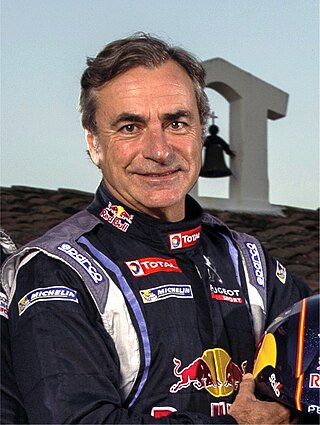
Carlos Sainz Cenamor is a Spanish rally driver. He won the World Rally Championship drivers' title with Toyota in 1990 and 1992, and finished runner-up four times. Constructors' world champions to have benefited from Sainz are Subaru (1995), Toyota (1999) and Citroën. In the 2018 season, he was one of the official drivers of the Team Peugeot Total. He received the Princess of Asturias Sports Award in 2020. Sainz founded the Acciona | Sainz XE Team to join Extreme E and competed in the first two seasons alongside Laia Sanz.
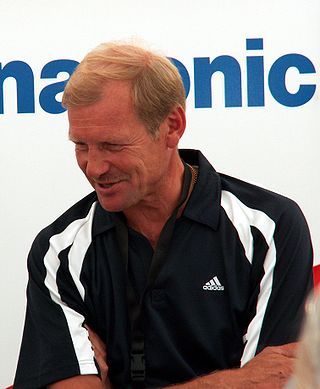
Juha Matti Pellervo Kankkunen is a Finnish former rally driver. His factory team career in the World Rally Championship lasted from 1983 to 2002. He won 23 world rallies and four drivers' world championship titles, which were both once records in the series. Both Sébastien Loeb and Sébastien Ogier have since collected more world titles, but no driver was able to repeat Kankkunen's feat of becoming a world champion with three different manufacturers until Ogier matched this achievement in 2020.

Group A is a set of motorsport regulations administered by the FIA covering production derived touring cars for competition, usually in touring car racing and rallying. In contrast to the short-lived Group B and Group C, Group A vehicles were limited in terms of power, weight, allowed technology and overall cost. Group A was aimed at ensuring numerous entries in races of privately owned vehicles.
Automobile was an American automobile magazine published from 1986 to 2020. It was founded in 1986 by a group of former Car and Driver employees, led by David E. Davis with support from Rupert Murdoch's News Corporation, using the credo No Boring Cars.

The Los Angeles Auto Show, also known as the LA Auto Show, is an auto show held annually at the Los Angeles Convention Center in Los Angeles, California, United States. It is open to the public for ten days, filling 760,000 square feet (71,000 m2) of exhibit space. Since 2006 the event is held in November or December.
Toyota Gazoo Racing Europe GmbH (TGR-E) is an automotive engineering and motorsport services facility based in Cologne, Germany. It is fully-owned and controlled by Toyota Motor Corporation.

Bburago is a large manufacturing company of toys and die-cast scale model cars formerly based in Italy. The company was based in Burago di Molgora, where all products were made from 1974 to 2005. At the height of its popularity, Bburago's main competitors were Politoys and Maisto, the latter of which was to become dominant in the 1:18 market segment around 2000.

The "Fast Response Car" (FRC) is the official term for police cars used by the Singapore Police Force. Prior to 2000, they were known in public simply as "police patrol cars".
The 1997 World Rally Championship was the 25th season of the FIA World Rally Championship. The season saw many changes in the championship. Most notably, Group A was partially replaced by the World Rally Car with manufacturers given the option which regulations to construct to. One inherent benefit to manufacturers by adopting WRC regulations was removing the need to mass-produce road-going versions of the cars that they competed with, under the previous rules for homologation. This meant that vehicles such as the Escort RS Cosworth and Subaru Impreza Turbo no longer had to be mass-produced for general sale in order to compete at World Championship level, and thus acting as a means of attracting increased competition and involvement by manufacturers. In the few years that follow, the Championship saw the added presence of WRC cars from companies such as Toyota, Hyundai, Seat, Citroën, and Peugeot, who would all compete under WRC regulations without having to manufacture equivalent specialised road cars for public sale. Both Ford and Subaru switched to WRC in 1997, except Mitsubishi who stayed with Group A to maintain the links to their Mitsubishi Lancer Evolution road cars. Subaru's transition was much more gradual for similar reasons with the early Subaru Impreza WRCs still largely Group A in nature.
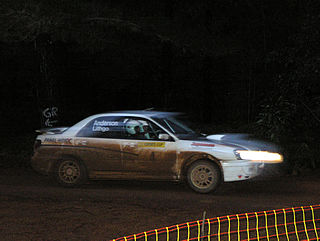
The Motorsport Australia Rally Championship, also commonly known as the Australian Rally Championship (ARC), is Australia's premier gravel rally competition. A multi-event national championship has been held each year since 1968, excepting 2020.

The Toyota Celica GT-Four is a high performance model of the Celica Liftback that was produced from 1986 to 1999, with a turbocharged 3S-GTE engine, and full-time AWD. It was created to compete in the World Rally Championship, whose regulations dictate that a manufacturer must build road-going versions of the vehicle in sufficient numbers. These vehicles are referred to as "homologation special vehicles".

Meccanica Bessana Toys, was an Italian toy manufacturer that produced die-cast scale model cars during the 1960s and 1970s.

Nicholas Mark Grist is a Welsh former rally co-driver, born in Ebbw Vale. His factory team career in the World Rally Championship lasted from 1993 to 2002. He won 21 rallies with more than one driver.

The Ford Escort RS Cosworth is a homologation special of the fifth generation European Ford Escort. It was designed to qualify as a Group A car for the World Rally Championship in which it competed between 1993 and 1998. It was available as a road car from 1992 until 1996. The powertrain was only fitted to this version of the Escort, a longitudinally mounted Cosworth YBT, a highly tunable turbocharged 2.0 L (1,993 cc) with a bore x stroke of 90.8 mm × 77 mm Inline-four engine which had an output of 227 PS in standard trim. Tuning companies have achieved power outputs in excess of 1,000 bhp.
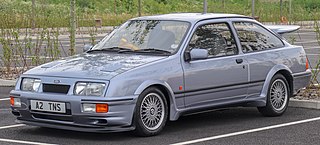
The Ford Sierra RS Cosworth is a high-performance version of the Ford Sierra that was built by Ford Europe from 1986 to 1992. It was the result of a Ford Motorsport project with the purpose of producing an outright winner for Group A racing in Europe.
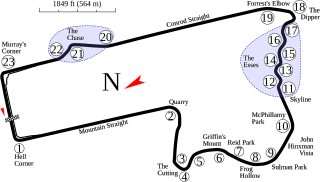
The Bathurst 24 Hour was an endurance race for GT and production cars held at the Mount Panorama Circuit in Bathurst, New South Wales in 2002 and 2003. Only two races were held before the collapse of the management organisation PROCAR. Both races were won by V8 Supercar team Garry Rogers Motorsport with Holden Monaros.
Procar Australia was a motorsport category management company which operated in Australia from 1994 to 2004.

The Lancia Delta HF is a Group A rally car built for the Martini Lancia by Lancia to compete in the World Rally Championship. It is based upon the Lancia Delta road car and replaced the Lancia Delta S4. The car was introduced for the 1987 World Rally Championship season and dominated the World Rally Championship, scoring 46 WRC victories overall and winning the constructors' championship a record six times in a row from 1987 to 1992, in addition to drivers' championship titles for Juha Kankkunen and Miki Biasion, making Lancia the most successful marque in the history of the WRC and the Delta the most successful car.